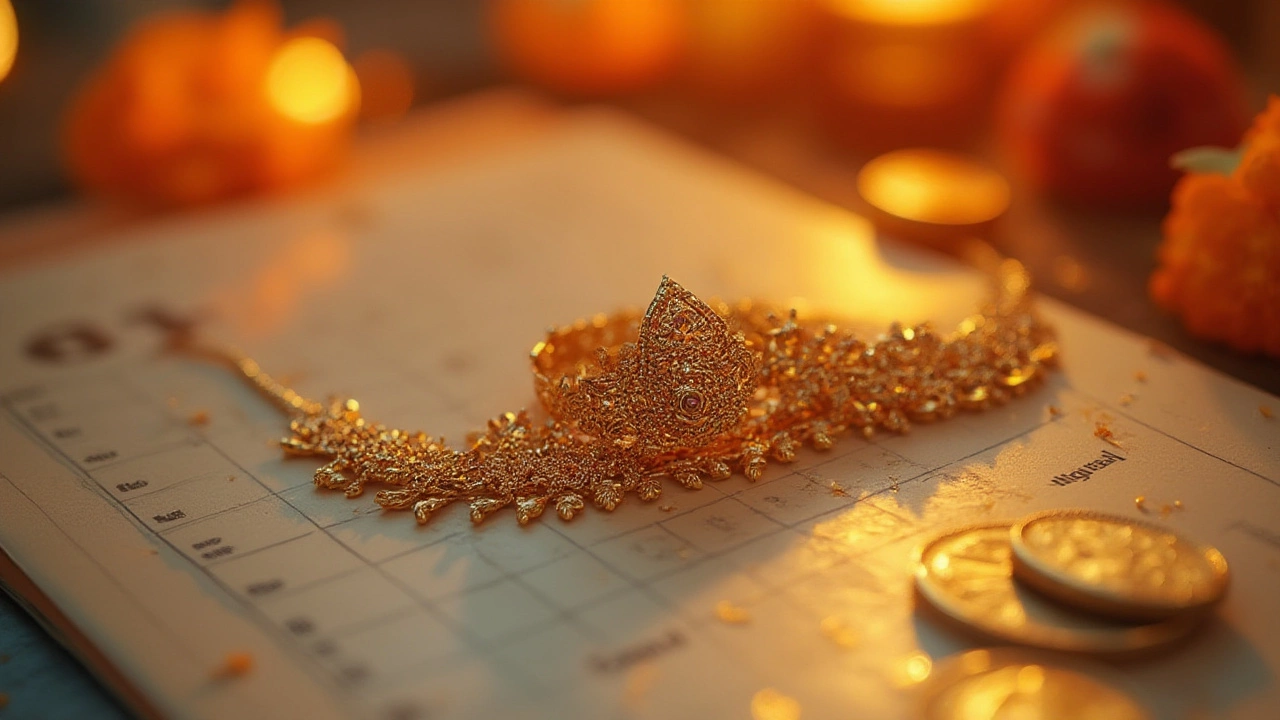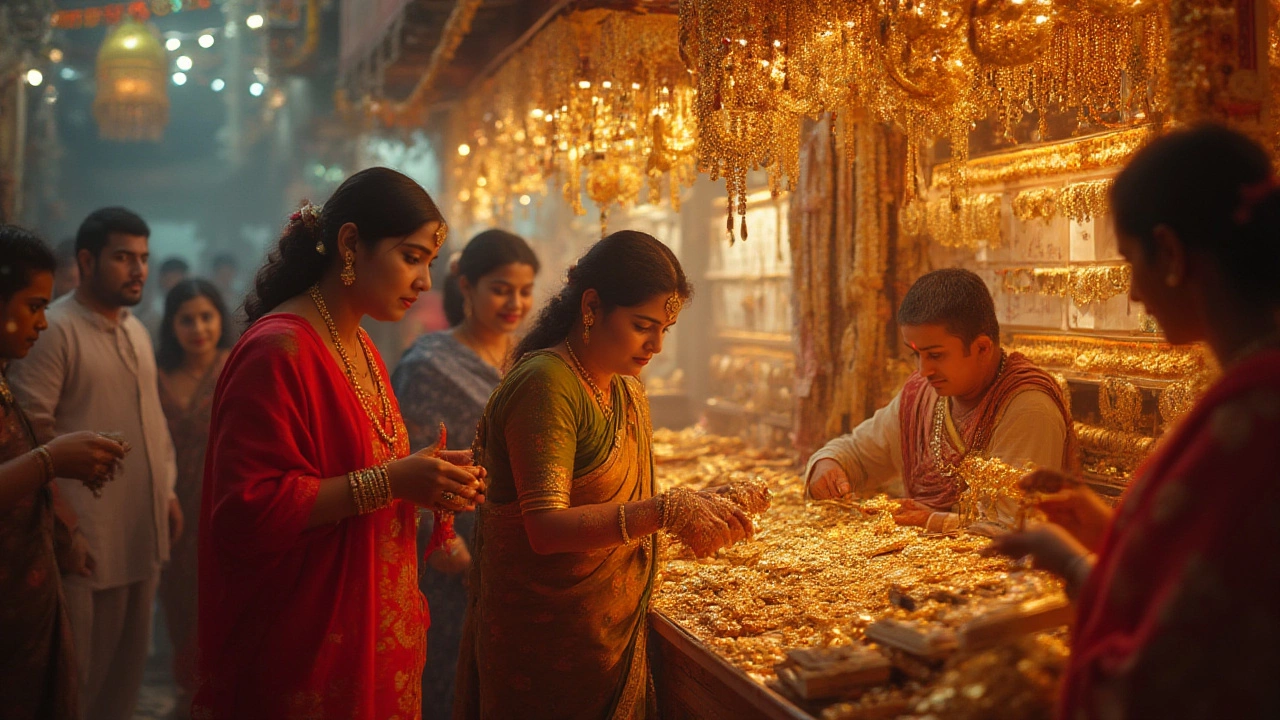If you’re one of those people who get a kick from tracking gold prices in India, then you know timing can make a big difference. Walk into a jewelry store in Chennai or Delhi in April and you might leave muttering about high prices. Shift that same shopping trip to June or August, and suddenly you’ve saved enough for a fancy dinner. There’s no magic involved, just a close look at how the gold market ticks.
Understanding Gold Price Trends in India
If you want to pick the best month to buy gold in India, you need to know how the market actually works, not just go by hearsay from your neighborhood uncle. Gold prices in India dance to the tunes of global trends, import duties, currency fluctuations, and even festivals. The price you see each day is a mix of what’s happening in London, New York, and Mumbai all at once. When global gold prices go up, so do prices in India—add to that any tweaks the government makes to import taxes or GST, and you could see a big jump in just a week.
Rupee versus Dollar plays a pretty crucial role. If the rupee weakens against the dollar, gold gets pricier for Indians, even if international prices are steady. And then, there’s good old inflation. When everything else is expensive, gold usually follows suit because people see gold as a safe bet during troubled times. One major fact to consider is India’s gold imports. Back in 2022-23, India imported around 800 tonnes of gold, making it the world’s second-largest consumer. Every gram comes at a cost determined by international markets, transportation, and taxes, making Indian gold prices unique and sometimes unpredictable.
Someone may ask, is there a perfect month every year when gold is cheapest? Well, it’s not quite that simple. Gold prices love drama. Sometimes, big moves happen around central bank announcements or geopolitical events—none of which care about your shopping calendar. But, over the years, data has shown that certain months do tend to offer lower prices. For instance, June, July, and August usually play it cool, with prices dipping before the festival madness begins.
It’s interesting how gold isn’t just a metal in India—it’s almost a calendar event. From Akshaya Tritiya to Diwali, the demand for gold spikes during these festivals, and naturally, prices often follow. Jewelers know when buyers flock to stores, so timing is everything.
Seasonal Factors and Festival Demand
Let’s get this straight: India buys more gold during festivals and weddings than at any other time. Akshaya Tritiya falls around April or May, and Diwali arrives in October or November, pulling millions of gold buyers into stores. So, guess when gold prices often hit their highs? You got it—just as everyone starts shopping for these celebrations. If you’re hunting for a bargain, avoid these periods.
Here’s a quirky fact: Reports from the World Gold Council keep repeating that gold demand in India surges up to 45% every quarter that packs big festivals or wedding seasons. That’s nearly half the year when prices try to climb. It shows up in price charts too. Historic data from 2015 to 2023 shows an average price spike of 3-7% during October-November, compared to the quiet summer months.
But what happens when there’s no big festival? June, July, and early August are kind of the "calm before the storm." Most jewelers even run quieter stores, sometimes offering discounts to boost sales. Buyers stay away because there’s no urgent reason to splurge on gold. Yet, those who do their homework know this is prime time for snagging deals. Even bullion traders keep their eyes open in these off-peak periods since there’s less frenzy and prices often see a gentle dip.
Let’s look at a snapshot. Here’s a table showing average gold prices over the past five years by month, from official trading data:
| Month | Average Gold Price (INR/10g) |
|---|---|
| January | 55,200 |
| February | 54,900 |
| March | 55,400 |
| April (Akshaya Tritiya) | 56,700 |
| May | 56,300 |
| June | 54,100 |
| July | 53,900 |
| August | 54,200 |
| September | 55,000 |
| October (Navratri/Diwali) | 56,900 |
| November | 57,300 |
| December | 55,500 |
So, if you bought gold in July instead of November, you could save nearly 3,000 rupees per 10 grams. That’s no small change if you’re making a big purchase.

Best Month for Buying Gold in India: The Data Speaks
All right, here’s the straight answer: Market trends say June and July are your best bets for buying gold in India if you want to save cash. Why? Demand for gold is at a lull, stores have less foot traffic, and jewelers try every trick to attract buyers before the wedding and festival seasons start. Sure, you might not bump into a Bollywood-style gold sale, but you’ll find better prices and maybe even some added discounts or free making charges thrown in.
It’s pretty common in metros like Mumbai and Kolkata to notice that gold prices dip in late June and stay steady through July and early August, before gradually moving up as the wedding season approaches in September. If you go by numbers, July wins the “cheapest month” title in most years. In 2022, for example, the average price in July was about 3% lower than in November—the peak buying time. Even in 2024, the pattern held.
If you’re saving up to buy gold for investment—like bars, coins, or even ETFs—then these cooler months are best. You don’t face festival drivers pushing prices higher. Retailers are willing to negotiate more on making charges, and some even offer zero-making-charge campaigns to clear inventory. Online bullion platforms, too, tend to offer special rates during these quieter months.
But keep one thing in mind: don’t just wake up on July 1 and buy blindly. Watch daily price movements. Sometimes, global events can shake things up, sending prices north even in these "cheap" months. Use gold price tracking apps or set alerts on platforms like the India Bullion and Jewellers Association (IBJA) site. If there’s a sudden dip—even for a week—that’s your cue to jump in.
- Gold prices tend to bottom out in July, based on 10-year average data.
- You can maximize savings by comparing online and offline rates—sometimes, pure gold coins are cheaper online.
- Jewelers in smaller towns may offer additional discounts during off-peak months to attract customers.
If you’re buying for a wedding that’s months away, the smart play is to lock in rates now with a gold saving scheme or a pre-booking—most big jewelers offer these options.
Tips for Gold Buying: How to Maximize Value for Your Money
If you’re not a regular gold buyer, the process can seem overwhelming. How do you make sure you’re not getting ripped off? First, always check the live gold price. Sites like IBJA or the Multi Commodity Exchange (MCX) update prices down to the minute. Don’t trust boards outside jewelry stores alone—they might lag behind actual market rates by a few hours or even days during high volatility.
Go for hallmarked gold. This is the Bureau of Indian Standards (BIS) stamp and it guarantees purity. In 2021, the Indian government made hallmarking mandatory in most districts, but you’ll still find older jewelry or coins without it floating around. Demand BIS hallmarking—every single time.
Compare making charges. Here’s where things get sneaky: jewelers might lure you in with a low gold rate, then slap on high making charges. Shop around, and don’t be shy about negotiating. Off-season months (like June and July) give you the strongest bargaining position. Making charges can range from 3% to 25% of the gold value, depending on design and brand. The more intricate the work, the pricier it gets. Plain-gold coins or bars? Making charges can drop as low as 1% in quiet months.
Don’t forget about GST. Since July 2017, you pay 3% GST on every gold purchase in India, in addition to making charges and the actual gold price. Factor this in, especially if you’re comparing with old bills or planning a big buy.
Digital gold has become a trend. Platforms like Paytm Gold and PhonePe Gold let you buy tiny amounts, even 1 gram at a time. The advantage? You can pick your timing to scoop up gold in low-price months and slowly build up your stash. Just stick with RBI-approved or IBJA-certified platforms to avoid risks.
- Check daily price notifications from trusted sources to spot sudden dips.
- BIS hallmarking must be visible on every gold item—don’t settle for less.
- Negotiate making charges or look out for zero-making-charge offers.
- Factor in GST and any payment method charges if buying online.
- For bigger investments, consider gold bonds or ETFs—their prices move with the market and let you skip making charges altogether.
Remember, dealers must provide a proper bill with detailed breakdown—gold price, weight, making charges, GST. This helps if you ever plan to resell.

Common Myths and Mistakes While Buying Gold
It’s so easy to get caught up in myths when you’re buying gold. The big one? Believing festival months like Diwali are when gold is cheapest. Reality is the opposite—festivals mean crowds, high demand, and gold prices inching up. Don’t get swayed by flashy ads or sales messages around these times.
Another myth is that all gold jewelry stores have the same gold quality and price. Big cities like Bangalore or Hyderabad have fiercely competitive markets, but neighborhood stores might charge more or sell lower-purity gold, especially in smaller towns. Always ask for BIS hallmark—even if the salesperson insists “it’s pure.”
Lots of people get trapped thinking online gold prices are always better. Sometimes, online stores include shipping or insurance charges that cancel out the savings, especially for physical gold delivery. Check the full cost, not just the "per gram" rate.
A classic mistake: ignoring resale value. If you’re buying gold jewelry, remember that the resale price depends mostly on current market rates minus melting charges and deductions for stones or non-gold parts. Plain gold coins or bars usually fetch the best resale prices, since they don’t have design components eating into returns.
- Don’t assume festival offers mean lower gold prices—check the market rate first.
- Resale values vary—jewelry with stones or intricate designs fetch less.
- BIS hallmarking is a safety net for purity—don’t settle for anything less.
- Online buys can sometimes slip in hidden fees—read the fine print.
- Buying during the off-season is the most reliable path to savings, not festival sales.
Want a smarter way? Many savvy buyers sign up for gold price alerts and save up during off-peak months, then lock in purchases when the price hits their target. And don’t rule out gold savings schemes. Most big jewelers now offer monthly deposit programs; these average out price fluctuations and often come with bonus offers for payments made in off-season months.



